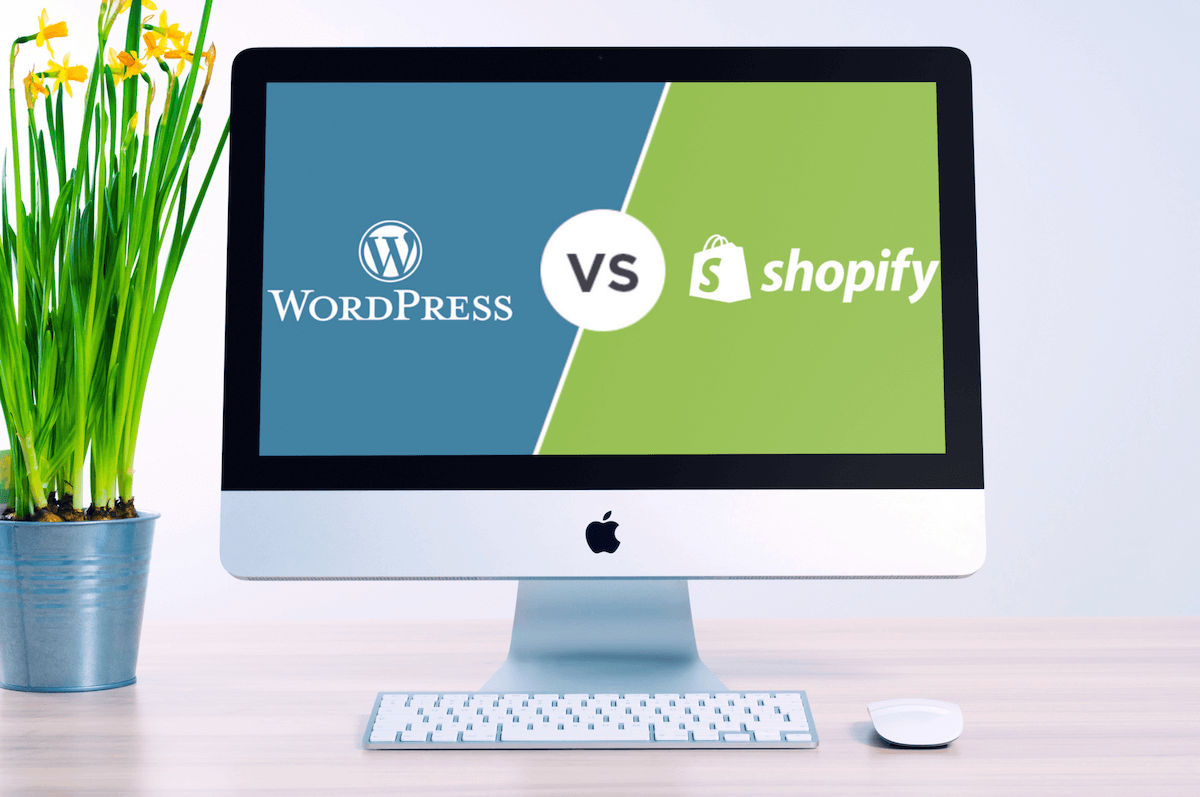E-Commerce: A new post-COVID19 need?
Due to the COVID19 pandemic, customer shopping preferences are changing drastically. Most customers prefer to go online rather than heading to the store directly! So if you are not reaching your customers online yet it’s time to start!
The first step is picking the right platform where you can sell your products. So far, the most common market offerings for startups and small businesses are Shopify and WordPress. Both platforms have their strong sides and weaknesses. Instead of getting caught in detail, we need to find out which complies with your needs and resources best. Let’s take a look at how to leverage WordPress or Shopify for e-Commerce.

//What’s the Difference?
- Shopify is a Software-As-Service (SaaS) e-Commerce platform. WordPress is two-fold: a hosted blogging platform (WordPress.com) and downloadable self-hosted software (WordPress.org.). Each software has its share of pros and cons, so to make the right decision on which to use it is recommended you consider your budget and overall business goals.
- Shopify works as a website builder where everyone can build an online store. Being a SaaS platform, you could rent a cloud service on a per-user/per-month basis. This gives you straightforward access to the platform features online.
- WordPress is an open-source Content Management System. You can download a self-hosted version from WordPress.org and change the code as you like. With WordPress you can build any website, but you need an e-Commerce plugin to run a store. One of the most popular is WooCommerce. This plugin creates a powerful pairing with WordPress and it is open-source too. So you can customize it any way you want.

//The Money Requirement:
Shopify offers a 14-day trial and four pricing packages. The higher the price, the more advanced functionality.
- Basic Shopify for startups with two accounts is $29/month
- Shopify for small businesses with five accounts is $79/month
- Advanced Shopify for large businesses with 15 accounts is $299/month
- Shopify Plus focuses on enterprises or businesses that need advanced API, uptime or support. Drop them a line to get a price.
You can get only WordPress software for free from WordPress.org. From there, other costs do apply:
- the hosting costs
- a domain name cost
- the SSL certificate cost
- the theme is available for free to as much you are willing to pay
- WooCommerce is free, but the other plugins add extra costs.
It all comes down to Shopify may be cheaper in comparison to running a store on WordPress. Also, each Shopify plan includes hosting, SSL certificate and a domain name.
//The Time Requirement:
To get started with Shopify, you need to choose a plan, buy it and sign in. Naturally, then you add your products, descriptions, write posts on a blog and so on. Simply set up your store in a few hours and make it ready and “open wide” for customers online.
WordPress requires a bit more effort and shows a higher level of mastery. First off, you need to buy a domain, then handle a hosting question. You can host it by yourself or by third-party services. Your next step is to choose a theme, install plugins and configure everything to make your shop go live. Unlike with Shopify, the journey with WordPress for e-Commerce will be longer. If you are going to use WooCommerce you will need a developer to configure your software from WordPress.org.

//Shopify VS WordPress – Advantage and disadvantages:
- Shopify being a cloud based application is one of the biggest advantages. Shopify acts as your hosting provider and offers an SSL certificate when you choose to use Shopify.
- The platform is responsible for its own infrastructure. Users do not need to worry about any performance issues or maintenance issues.
- The platform itself takes care of any and every technical update which lets the user access the most updated version at all times.
- Shopify’s ecommerce plugins are verified, secure and vetted which keeps their user safe from online malwares and hacking issues.
- Shopify offers their own payment system which is secure and easy to set up.
Disadvantages:
- Shopify owners have very little control over their online store vs WooCommerce that offers complete customization and control over the online store.
- Shopify limits a web designer’s ability to fully customize and tailor the online store branding or owner’s preferences. The control over CSS and HTML customization is limited in some aspects.
- Shopify uses a programming language called “Liquid”. Not all the developers are familiar with this programming language. This creates a barrier to finding developers who are familiar with “Liquid” who can then build your store.
- Basic Shopify requires a monthly fee of $29 while the most robust Shopify option costs $299 per month. The platform also charges an added percentage on these fees. The monthly fees will only become more expensive.
- Shopify requires online store owners to select from a preset list of payment gateways. The platform also charges an added percentage on these fees.
WooCommerce (WP): Advantages
- WooCommerce boasts the most extensive online support community and app store in the world. WordPress also powers more than one-third of all websites on the internet. Due to this advantage, managing huge and complex stores with their websites is much easier than Shopify.
- WordPress offers the most extensive plugin library in the world, ensuring that integrations and customizations for WooCommerce are available for everyone, even those moving from Shopify to WordPress.
- Users own their store completely. Which means it can be on your own server. WooCommerce offers site owners and web designers complete control over the design and customization of their online store. It offers extensive flexibility to developers.
- Users are also in control of their servers where they are storing their site. This makes it easy for users to enhance the performance of their store.
- WooCommerce can be set up quickly and integrated into an existing WordPress site without interruption and connected with virtually any payment gateway.
Disadvantages:
- Site owners or their web developers should stay on top of WooCommerce plugin updates to maintain security and add new functionality to their online store. These constant updates are time consuming, but if you find a good team such as Graphem Solutions who can take care of it then it reduces the site owner’s stress significantly.
- Even though adding multiple plugins isn’t an issue, sometimes too many plugins may end up overlapping and conflicting in their functionalities. So it is recommended to do enough research before to determine ideal plugins.
- Web store owners need to procure their own hosting provider and SSL certificate to make sure their online store operates smoothly.
//Conclusion:
Considering switching your current store to Shopify or WooCommerce or build a completely new one? Reach out to Graphem Solutions Inc, who will help you choose the best migration strategy based on your needs and requirements.



